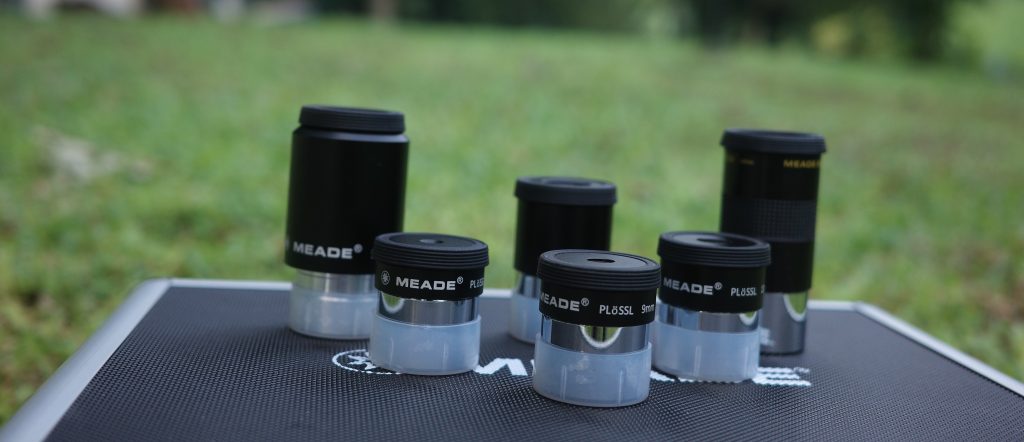
Most telescope packages come with one or two eyepieces, which give us one or two magnification options. But this is not enough to let us take full advantage of the light-gathering ability of our telescope.
My colleague Zane Landers and I want to help you choose the best eyepieces for your telescope and your budget. To do that, we’re going to organize the guide around five questions and four formulas.
Questions (clickable to their respective sections):
- What is my budget per eyepiece?
- What diameter eyepieces will my telescope accept?
- What focal length eyepieces should I buy?
- What apparent field of view and eye relief do I want?
- How will my telescope’s focal ratio affect my purchases?
Formulas:
- Magnification or power = focal length of telescope / focal length of eyepiece
- True field of view, or FOV = Apparent field of view (AFOV) of the eyepiece / magnification
- Focal ratio = focal length of telescope / aperture of telescope
- Maximum practical magnification of a telescope = 40-60x per inch of aperture, or 1.6-2.5x per mm of aperture.
As we go along, I will refer back to these, so don’t worry if you can’t answer the questions or understand the formulas now.
At the end of the guide, I will make some eyepiece recommendations by price range. If you just want the recommendations and don’t care about the details, just skip to the end. But I think you will feel more confident about your purchases and be less likely to be disappointed if you read through the guide.
What’d Be a Good Budget?
Budget drives all decisions. As you go up in price, you gain features or performance or both. Do you need to have the best to enjoy astronomy? That is up to you and your budget. I don’t think so.
Over time, you’ll likely spend more on eyepieces than on the telescope itself. But even if you upgrade or add a second telescope, the eyepieces will still work, as they come in standard sizes.
- Eyepieces under $100 each are generally considered budget or low-cost eyepieces.
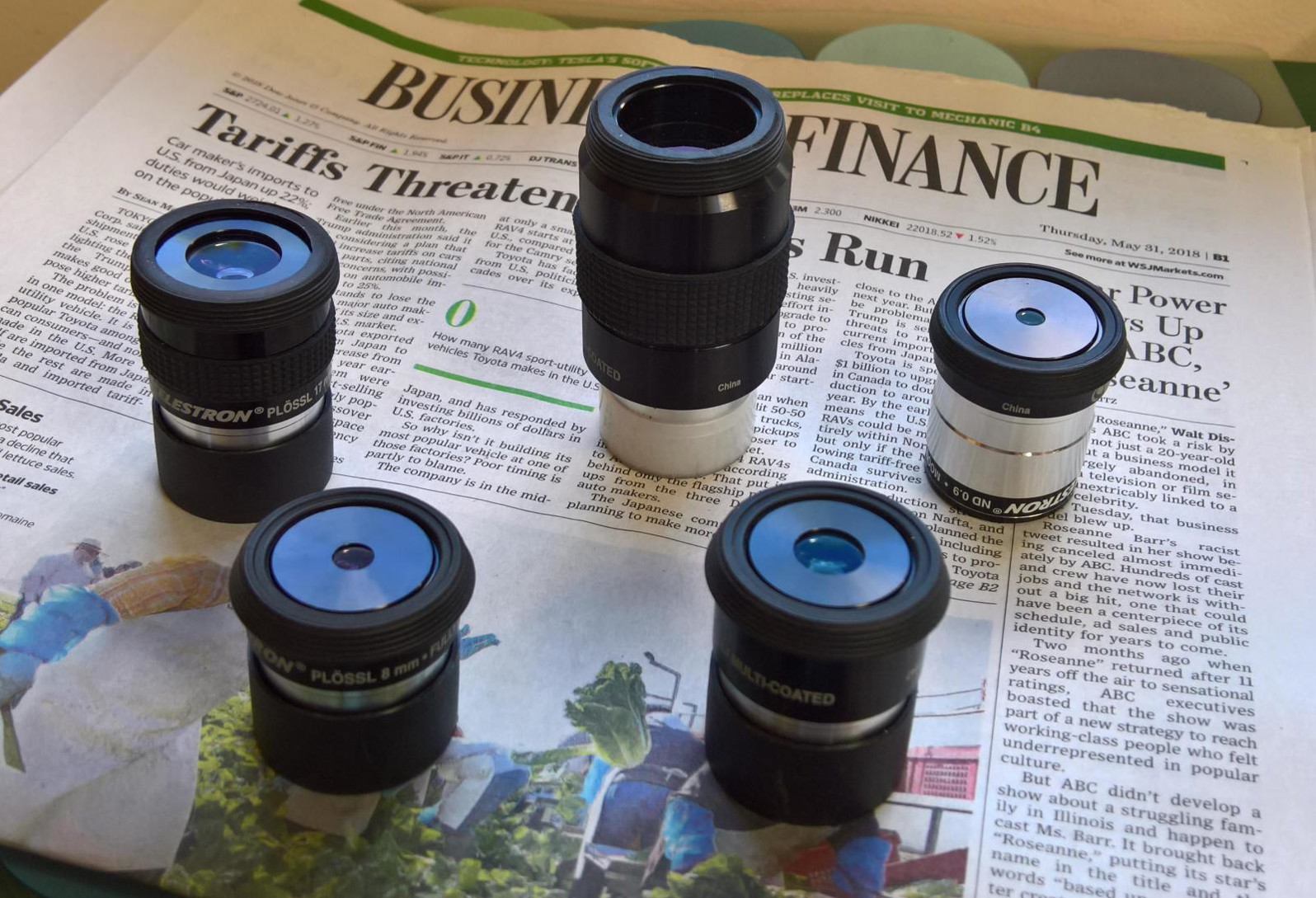
There are some very good choices in this range. Think of these as your Ford, Chevy, and Toyota of eyepieces. They work great every day and get you where you want to go, but they don’t have what the higher-priced models have.
Skip to $50 eyepiece recommendations
- Between $100 and $250, I will call it mid-range.
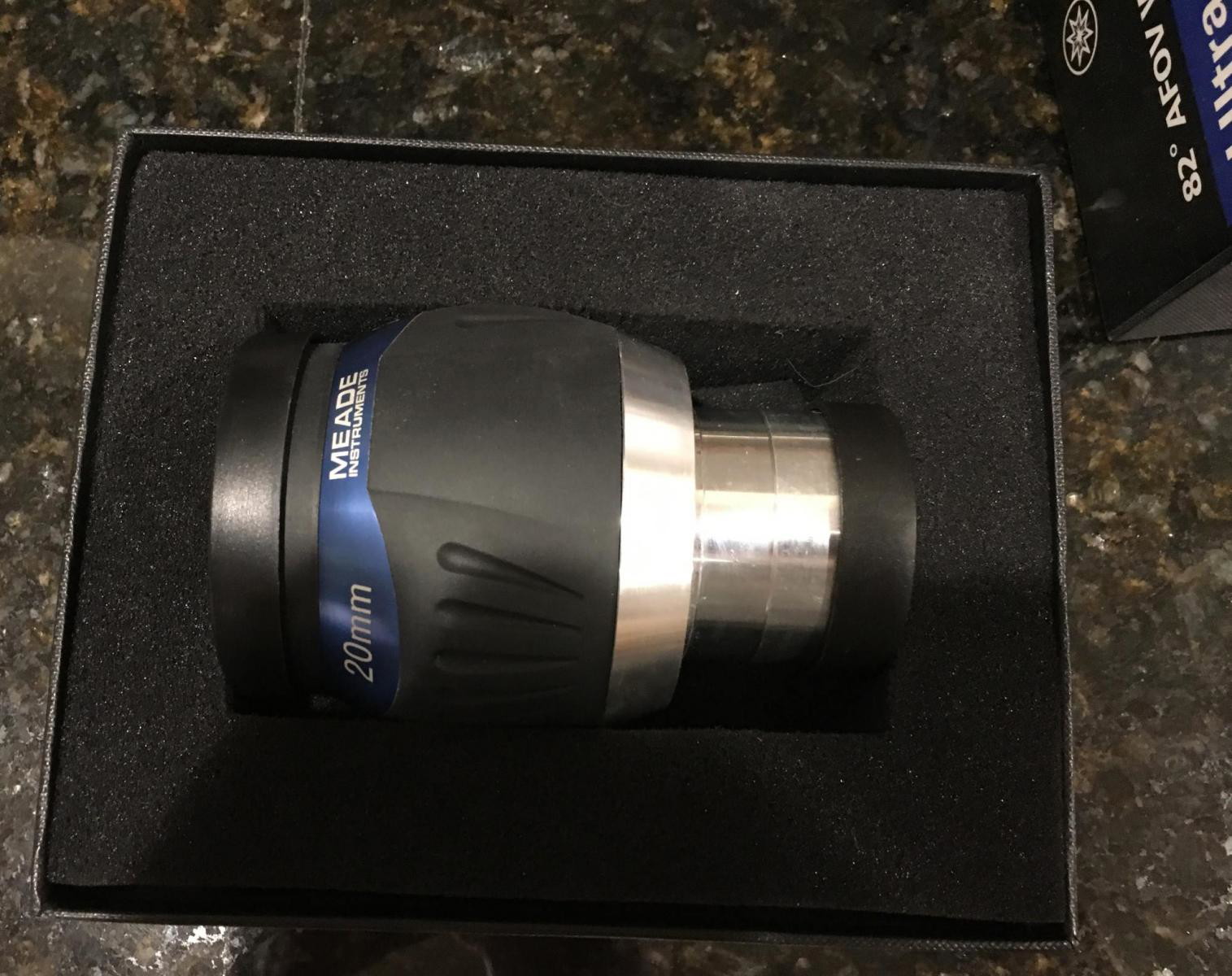
These are your Lexus, Acura, and Infiniti types—offering more features, a better build, and a bit more polish. Many approach the quality of the premium brands. In this range, you’ll find very good eyepieces with some extra features.
Skip to $200 eyepiece recommendations
- Over $250, I will label premium eyepieces.
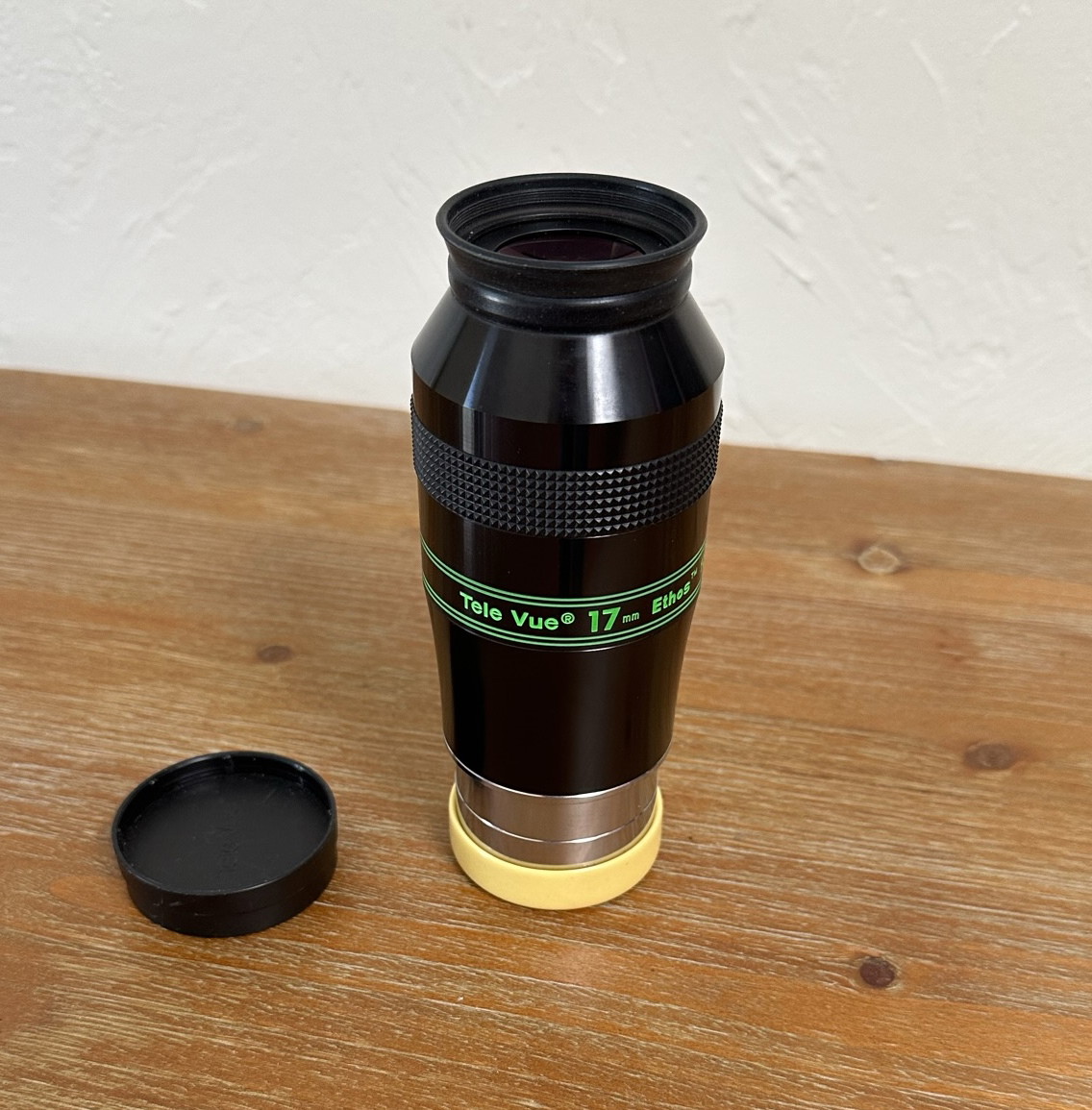
Here we get into the BMW, Cadillac, Porsche, and Ferrari of eyepieces—best in both optical performance and build quality. The price can even run to over $1000 per eyepiece. It costs a lot to get that last 10% of performance. If you are very demanding and must have the very best, this is where you want to be.
What Diameter Eyepiece To Buy?
Most modern telescopes use a focuser or diagonal that accepts 1.25” barrel size eyepieces. Some of these telescopes accept 2” eyepieces and even include an adapter to also accommodate 1.25” eyepieces. These two sizes—1.25” and 2”—are the current industry standards. Take a look at your telescope’s manual or user’s guide—it should specify what size eyepieces your telescope can take.
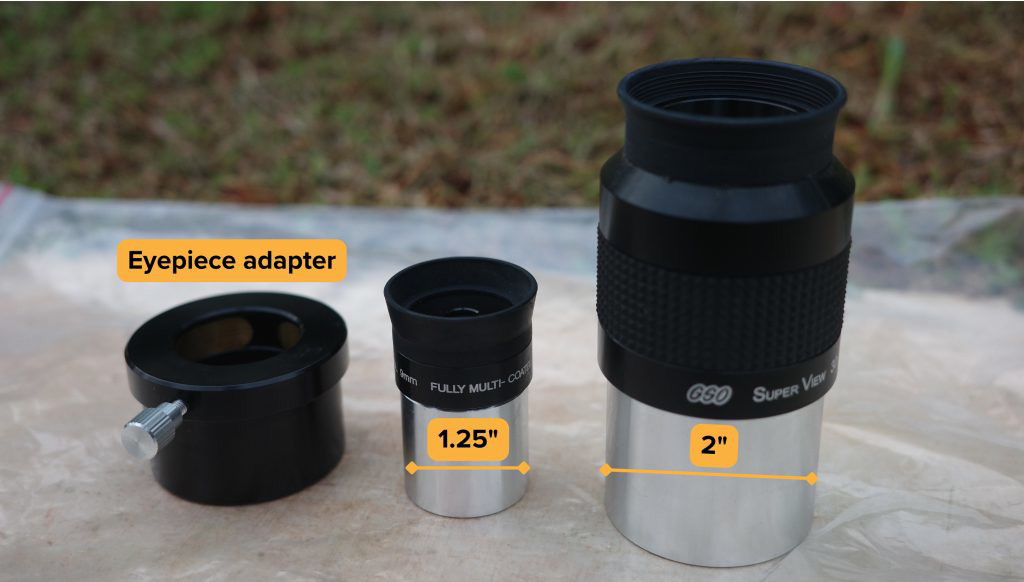
A 2” barrel size allows manufacturers to create eyepieces that provide a wider field of view. However, just because an eyepiece is 2” doesn’t mean it has a wider field than a 1.25” eyepiece. We’ll discuss field of view in more detail later, but note that if your telescope supports 2” eyepieces, you’ll typically get just one 2” eyepiece for low-power, wide-field views—all the rest will likely be 1.25” eyepieces.
Your eyepieces don’t need to be the same brand as your telescope. There is a very wide range of brands and styles to choose from. For example, using a Celestron branded eyepiece in a SkyWatcher branded telescope is no problem at all.
If your scope uses eyepieces that are closer to 1”, then you have an old style .965” that is now considered obsolete. You can still get some .965” eyepieces, but there are only few choices. There are inexpensive adapters that will let you use standard 1.25” eyepieces in a .965” focuser/diagonal. However, there can be a problem bringing the eyepiece into focus. I haven’t included .965” eyepieces in the product recommendations that follow.
What Focal Length Eyepieces To Buy?
Most telescopes come with one or two eyepieces—typically around 25 mm and 10 mm or something close to that. These provide a low-power view and a medium-to-high power view, depending on your telescope’s focal length. However, they’re mainly intended to get you started.

Each eyepiece gives you a unique magnification based on this formula:
- Telescope focal length ÷ Eyepiece focal length = Magnification (or power)
Why do you need more than two eyepieces?
Because some objects look best at low power, others at medium, high, or even very high power. It’s that simple—not everything in the night sky benefits from high magnification.
Also, atmospheric conditions can limit how much magnification you can use on a given night. If you look up transparency and “seeing” in the context of telescopes, you can learn more about how atmospheric conditions affect what magnifications we can choose on any given night. The bottom line is that it is best to have several magnification choices so you can optimize the view.
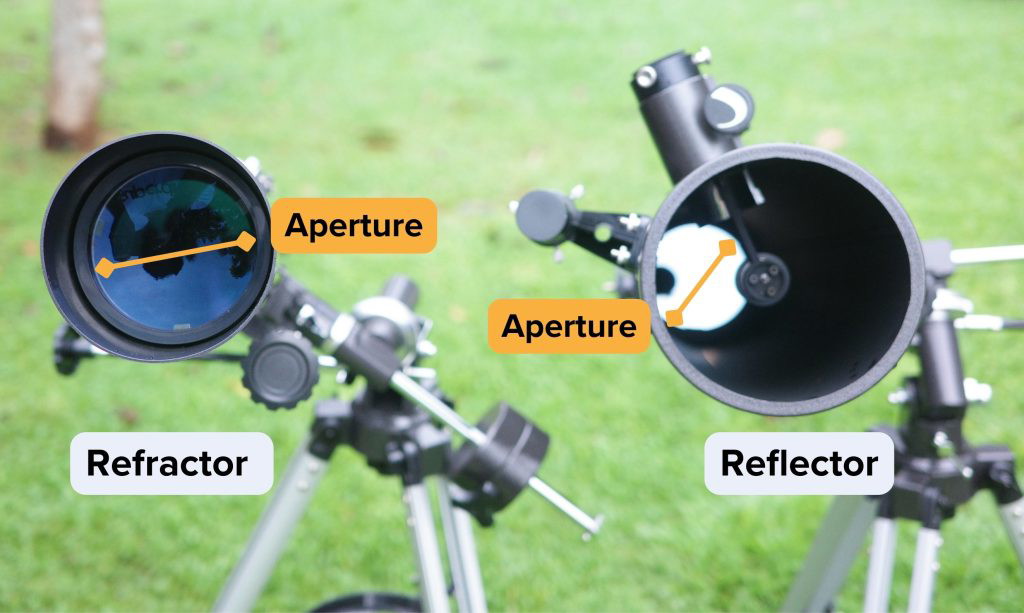
To determine a useful magnification range, we will start with the aperture of the telescope—the diameter of the front lens (in a refractor) or the main mirror (in a reflector). This determines how much light the telescope will gather. The more light that is gathered, the more magnification that can be applied to the image, up to the limits that are imposed by the atmosphere.
The Highest Magnification Limit
To estimate the highest practical magnification for your telescope, multiply its aperture in millimeters (mm) by 2. This gives you a general upper limit for planning purposes. Nothing will stop you from trying to go higher, but in all likelihood, the image will be poor and not worth the added cost of high-power eyepieces.
For example:
- 70 mm scope will have a max of 140X for planning purposes.
- 130 mm scope will have a max of 260X for planning purposes.
Keep in mind: These are just planning targets There is no guarantee that you will be able to get a good image of any given target at that level of magnification on any given night.
The atmosphere is typically the limiting factor as we get to higher magnifications. Even big telescopes are subject to limitations imposed by the atmosphere.
In practice, even with big telescopes, it is unlikely you will be able to use over 300x under even good skies fairly frequently. Magnifications above 500x are seldom useful for anything but planetary nebulae and the tightest double stars. Above 800-1000x is almost never required or possible.
Now we have a maximum established. Let’s look at the minimum.
The Lowest Magnification Limit
In this case, I am going to define this by the focuser and eyepiece size.
If your focuser/diagonal only accepts 1.25” eyepieces, I recommend using a 32 mm eyepiece as your lowest magnification eyepiece. This is typically the widest field of view you can achieve with a 1.25” format.
If your focuser or diagonal accepts 2” eyepieces, then I will suggest you get one or two 2” eyepieces for your low-power, wide-field viewing purposes. Consider something between 35 and 40 mm in focal length with an apparent field of view (AFOV) of 65° or wider. We’ll cover AFOV in more detail later in the article.
Sample Calculation For a 100mm Telescope
Now we can establish a target magnification range. I hope you still remember the formula:
Focal length telescope / focal length eyepiece = magnification or power
Let’s give an example. We will use a 100 mm telescope with a 600 mm focal length that only takes 1.25” eyepieces.
Low Magnification = 600 mm focal length of telescope / 32 mm focal length of eyepiece (as per my recommendation for telescopes with 1.25″ focuser) = 18.75X
To achieve a maximum magnification of 200X (2X the aperture of 100 mm), as per the above formula, Focal length eyepiece = Focal length telescope / Magnification.
600 mm / 200X = 3 mm. 3mm will be the focal length of our highest power eyepiece.
We have now established magnification range of 32 mm to 3 mm for the 100mm telescope with a 600 mm focal length. Now, between 3mm and 32mm of focal lengths, you can buy any number of eyepieces. Some people have more than 6 and some have as few as 3. I am going to use 6.
32 mm = 18.75X
12 mm = 50X
8 mm = 75X
6 mm = 100X
4 mm = 150X
3 mm = 200X
Note that as we get into the higher magnifications, the millimeter jumps between eyepiece focal lengths gets smaller. Your focus should be on the magnifications rather than the mm of the eyepieces.
If your telescope has a different focal length, simply substitute it into the formulas above to calculate your telescope’s practical magnification range.
Using Barlow Lens For More Magnifications
A Barlow lens can save you money and add flexibility, if you decide to use one.
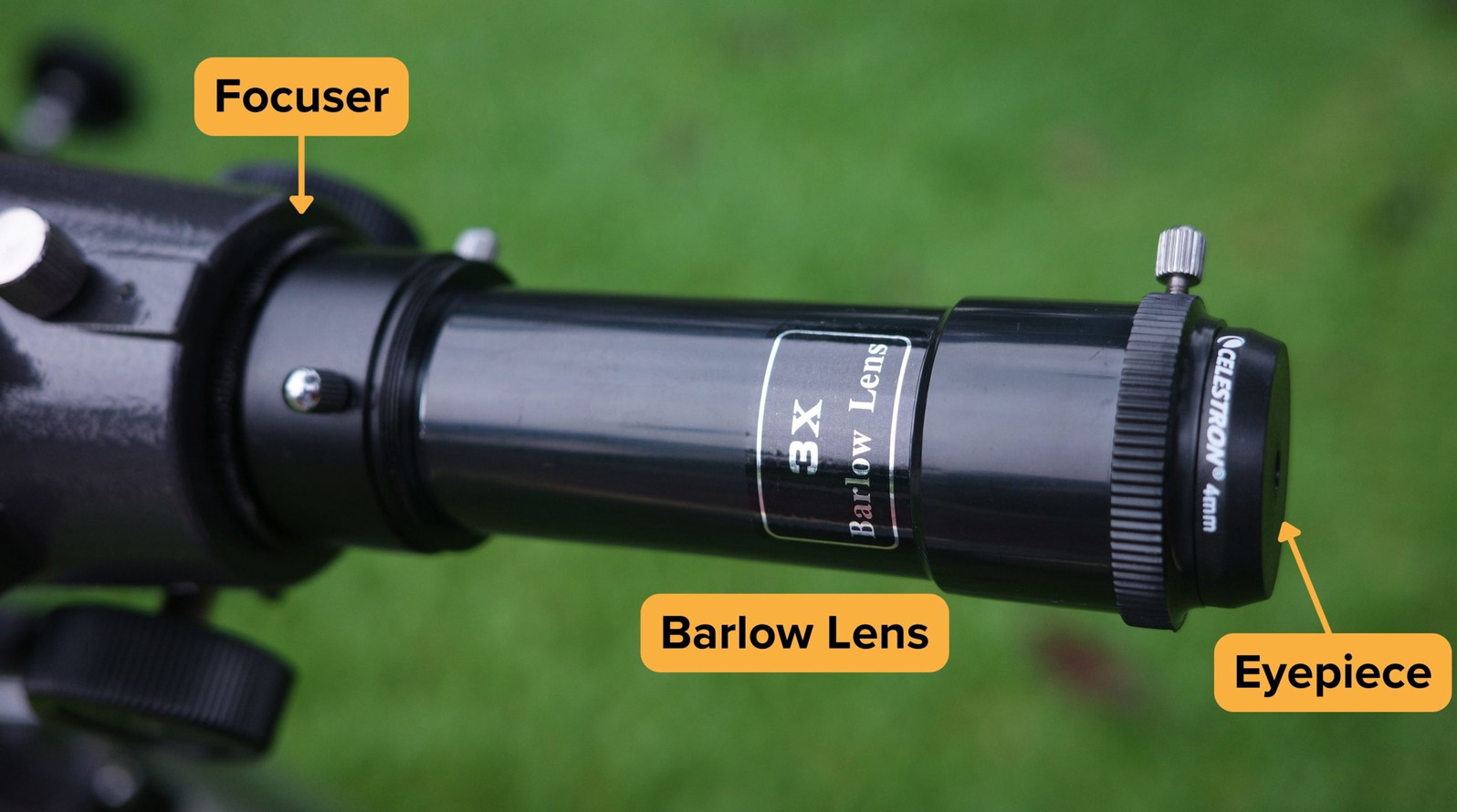
A Barlow lens is an optical device that fits between the eyepiece and the focuser. Named after Peter Barlow, who invented it in the 1800s, it’s typically capitalized. It allows each eyepiece to provide two magnifications. For visual observing, 1.5X, 2X, 2.5X, and 3X Barlow lenses are common, while higher magnifications are usually reserved for astrophotography.
If you put a 30 mm eyepiece in a 3X Barlow, it will triple the magnification you get from that eyepiece. Another way to look at it is that a 30 mm eyepiece in a 3X Barlow works like a 10 mm eyepiece.
To achieve six different magnifications, you can have six eyepieces—or use three properly sized eyepieces with a Barlow lens to achieve three more magnification options. The second is usually a less expensive way to go.
I often recommend using a Barlow to extend the range of magnifications. In the beginning, you won’t know what the atmospheric conditions might be in your area. In our earlier example, we targeted 200X as the top magnification. But you may only be able to achieve that rarely. So perhaps you do your lineup like this if you use a 2X Barlow lens:
- 32 mm = 18.75X (a 2X barlow will give you 37.5X like a 16 mm eyepiece)
- 12 mm = 50X (If you have a 25 mm that came with your scope, you can use a 2X Barlow for 12.5 mm effective focal length instead of buying a 12 mm eyepiece separately)
- 8 mm = 75X
- 6 mm = 100X
- 4 mm = 150X (You can reuse the earlier mentioned 8 mm eyepiece with a 2X Barlow instead of buying a 4 mm)
- 3 mm = 200X (You can reuse the earlier mentioned 6 mm eyepiece with a 2X Barlow instead of buying a 3 mm)
Using this approach, you would buy a 2X Barlow and hold off on the 4 mm and 3 mm to see if you can reach these magnifications often enough to justify buying an eyepiece. Or, you may find that you like the 8 mm and 6 mm used with the Barlow and can avoid the expense of two eyepieces.
Note that we also gained a 16 mm magnification at no additional cost.
But you should be beware that cheaper Barlows can often be low quality and any Barlow may result in issues with reaching focus, your focuser itself sagging, balance, etc. As such, I usually recommend a fixed focal length eyepiece instead of a Barlow if you’ve got the budget. But for those on a budget, a good Barlow lens can serve you well.
Exit Pupil & Its Importance in Eyepiece Choice
The exit pupil is the diameter of the light beam exiting the eyepiece, usually measured in millimeters (mm). Our eyes can’t dilate much over 7 mm (or 6mm if you’re elderly), so any light beyond this exit pupil size is essentially wasted.
- Exit pupil = focal length of eyepiece / telescope focal ratio (also, aperture of telescope in mm / magnification)
For the earlier example of a 100mm aperture telescope with an f/6 focal ratio, a 12mm eyepiece gives 2 mm of the exit pupil (12mm / focal ratio 6). Likewise, a 32 mm eyepiece will give an exit pupil of 5.33 mm.
Larger exit pupils provide a brighter background (worsening contrast, especially under light-polluted skies) and lower power—but condense the brightness of dimmer extended objects.
Generally, you want to use an eyepiece that provides an exit pupil of
- 2-4 mm for galaxies
- 4–7 mm for emission nebulae and open star clusters (if your skies are dark and/or a filter is used)
- 1-2 mm for globular star clusters
Very small exit pupils (and thus high powers) are ideal for the Moon, planets, double stars, and planetary nebulae. However, it can be tricky to line your eye up. Also, higher magnifications are more affected by atmospheric turbulence and the telescope’s optical imperfections. Also, in the case of the Moon and planets, if you’ve got small floaters in your eyeball, it might become more pronounced as those black spots might be large in relation to a small, sub-mm exit pupil and can be an irritant, eclipsing your view or causing a headache.
What Field of View and Eye Relief do You Want?
We will now discuss the specifications of eye relief and apparent field of view. These are two very important considerations when you are looking for eyepieces.
Eye Relief:
Eye relief refers to how close your eye needs to be to the lens in order to see the entire field of view. Most people will be fairly comfortable with an eye relief of 12 mm or more. However, some eyepieces have an eye relief as short as 5 mm. They are usable, but your eye will be extremely close to the top lens glass.
If you are a glasses wearer and plan to keep your glasses on while you are observing, then you will likely want eyepieces with at least 17 mm of eye relief. Some glasses wearers prefer at least 20 mm. With your glasses on, you simply can’t get your eye close enough to an eyepiece that only has 10 mm of eye relief.
Note that, unless you have severe astigmatism, glasses are unnecessary. The only effect of severe near- or far-sightedness is a different focus placement than people with good vision, though in more mild cases this effect is negligible.
Apparent Field of View:
This is a measure of how wide a view an eyepiece provides when looked through directly, without adding it to a telescope. It’s expressed in degrees (°) and can range from 30 degrees to 120 degrees, and is inherent to the eyepiece’s design.
However, the true angular diameter of the view when the eyepiece is added to a telescope is a different metric and is dependent on both the eyepiece and the telescope being used. This is where the following formula comes into play:
- True field of view or FOV = Apparent field of view (AFOV) eyepiece / magnification
Let’s illustrate with an example using a 1200 mm focal length telescope. We will use 10 mm as the eyepiece focal length, but we will look at three different 10 mm eyepieces, each with a different apparent field of view, AFOV.
Note that the full moon appears to be approximately .5 degrees across, so use that as a mental reference when looking at the numbers. Imagine you are looking at the moon with each of these eyepieces and consider what you would see.
1200 mm FL scope / 10 mm FL eyepiece = 120X Magnification
40 degree AFOV / 120X = .33 degrees (less than 1 full moon wide)
60 degree AFOV / 120X = .5 degree FOV (about one full moon with no space around it)
82 degree AFOV / 120X = .68 degree FOV (about one full moon with a star field around it to frame it)
In general, the higher the AFOV number, the more the eyepiece will cost. It’s harder to make wider-AFOV eyepieces that present a good image all across the field of view, which drives up the cost.
When discussing eyepieces, you’ll often hear people comment on how well the eyepiece is “corrected.” They are referring to how much or how little distortion is visible as you look from the center of the image out toward the edge of the field of view.
2” eyepieces have an advantage over 1.25” eyepieces when designers are making wide-view eyepieces. The larger barrel allows them to create an eyepiece with a higher AFOV. That is why I suggest, if you can use 2” eyepieces, you will want one or two low-power wide-view 2” eyepieces in your collection. If your setup only accepts 1.25” eyepieces, a 32 mm Plossl with a 50-degree AFOV gives you about as wide a field of view as you can get in a 1.25” eyepiece.
When you add eyepieces to your collection, consider what field of view you want and how much you’re willing to pay for it. Note that many cheap eyepieces promise wide AFOVs but deliver a view with a lot of distortion or aberration as you move away from the center of the field of view.
Here are a few types of eyepieces you may read about and their typical AFOV. I’ve added comments on where you may find and use them.
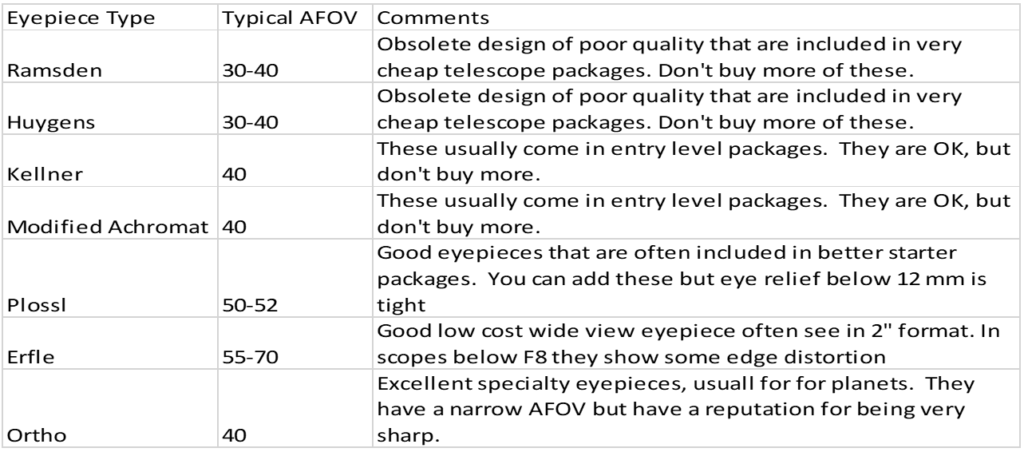
There are many more designs that are associated with specific brands, but the ones above are designs that are produced by many companies in one form or another. And new proprietary designs come out from time to time.
After these, we have mostly proprietary designs from various eyepiece companies. In most cases, these are eyepieces that are focused on wider AFOV or better correction for low focal ratio scopes. These tend to run toward the more expensive price range.
How Will My Telescope’s Focal Ratio Affect Eyepiece Purchases?
In simple terms, high focal ratio telescopes, say those over f/6, tend to be less demanding on eyepieces than those below f/6. Depending on how fussy you are about having a completely clean image across the visual field, if you have a lower focal ratio scope (also known as fast scopes), you will want to look for eyepieces with a reputation for being “better corrected” in low focal ratio scopes.
In low focal ratio scopes, light rays get delivered to the eyepiece at an ever-increasing angle as the focal ratio goes down. This can cause aberrations in the image as we move from the center of the view toward the edges. I’m not going into all the types of aberrations that can be there. Let’s just say that once you get below f/5, it is really hard for an eyepiece to deliver a clean image at the edges of the field of view.
Also, as the apparent field of view gets wider, the image will require more correction. Again, this is more noticeable in fast scopes.
So, if your scope is f/6 or lower, or you’re looking at eyepieces that are wider than 55 degrees AFOV, you may want to consider some of the higher-priced, better-corrected eyepieces if you want the best image to the edge of the field. It all comes down to cost-benefit. You have to decide how fussy you are about the edges and what your budget can tolerate.
Does the type of target matter?
Perhaps you have read about planetary eyepieces, DSO eyepieces, and other types of specific eyepieces. Do you really need a separate 10 mm planetary and a 10 mm DSO eyepiece? In my opinion, no.
Unless you are a professional astronomer or extremely demanding, you can select your eyepieces based on magnification, the apparent field of view, eye relief, and price. You can use the same eyepiece on planets and deep-sky objects (DSOs). Over time, you might wish to add a specialty eyepiece here or there, but I would not make that a priority until you have filled out your magnification range.
Recommendations: The Best Telescope Eyepieces We Know
What follows are specific eyepieces that I or my colleague Zane Landers have tried, own, or have read so many good reports about that we feel very comfortable recommending them.
1. Under ~$50: Redline/Goldline Eyepieces
Available 1.25” focal lengths: 20mm, 15mm, 9mm, 6mm

- The average 66-degree AFOV of the goldline/redline series provides a 32% wider field of view (FOV) than the similarly priced Plossl eyepieces. This wider FOV makes it easier to find my targets, allows us to view larger deep-sky objects, and provides a more immersive experience.
- Offer better eye relief than Plossl eyepieces, especially at shorter focal lengths.
- Edges of the optics are blackened for increased contrast, which prevents internal reflections
These series of eyepieces can be recognized by a thin gold or red line just below the eye cup.
I’ve only found minimal optical differences between “redline” and “goldline” eyepieces. But I’ll put up the redlines as a little more well-constructed, not to mention that the redline also look quite a bit prettier to me.
Goldline/Redline eyepieces are available in 6mm, 9mm, 15mm, and 20mm focal lengths.
The 20mm and 6mm boast a 66-degree apparent field of view, while that of the 9mm and 15mm is closer to 70 degrees, despite claimed specs. The 20mm and 15mm are of the Erfle design and do not work great in telescopes faster than f/5-f/6, while the 9mm and 6mm are outstanding in pretty much any telescope.
Many brands of goldline/redline eyepieces are available, including SVBONY UltraWide, Astromania UltraWide Angle, Agena Astro StarGuider Enhanced UltraWide Angle, and others. They are all made by the same OEM manufacturer and the above-mentioned companies rebrand them under their own names. Other trustworthy brands selling these oculars include MEOPTEX, Yosoo, and Omegon.
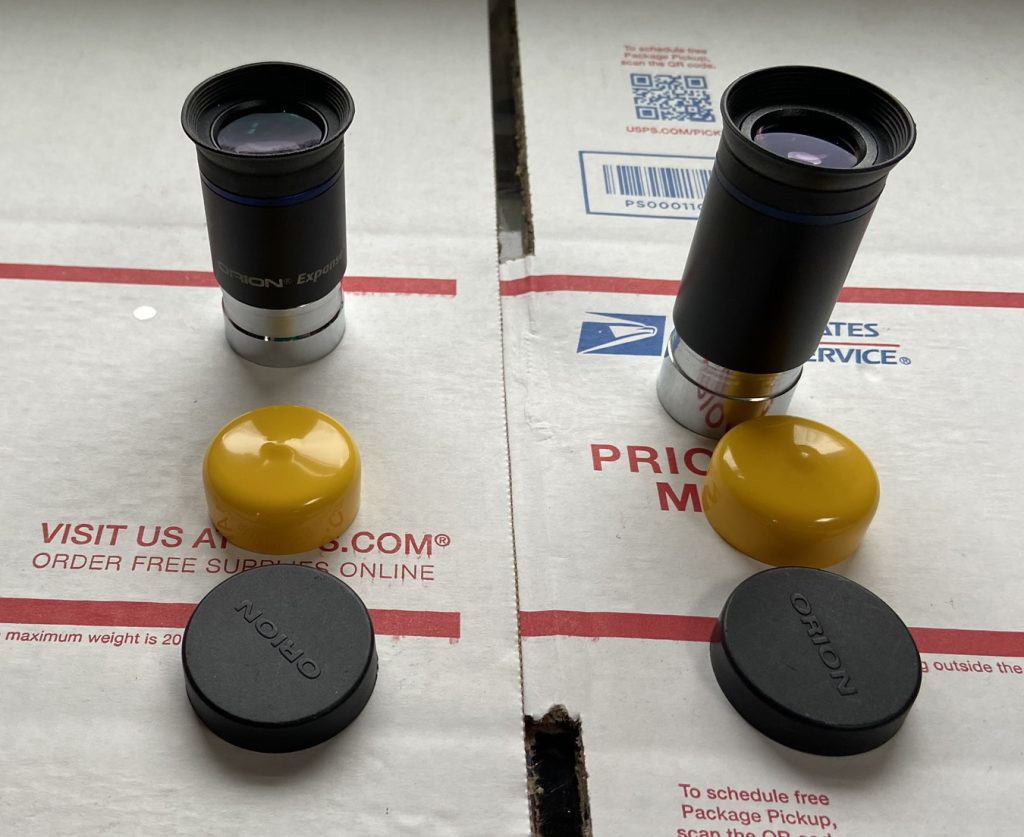
I recommend picking up the SVBONY version if you are in the US, simply because it is the cheapest of all.
2. $50 to $100 Range: Agena Astro 1.25″ Starguider Dual ED
Available 1.25” focal lengths: 25mm, 18mm, 15mm, 12mm, 8mm, 5mm, 3.2mm
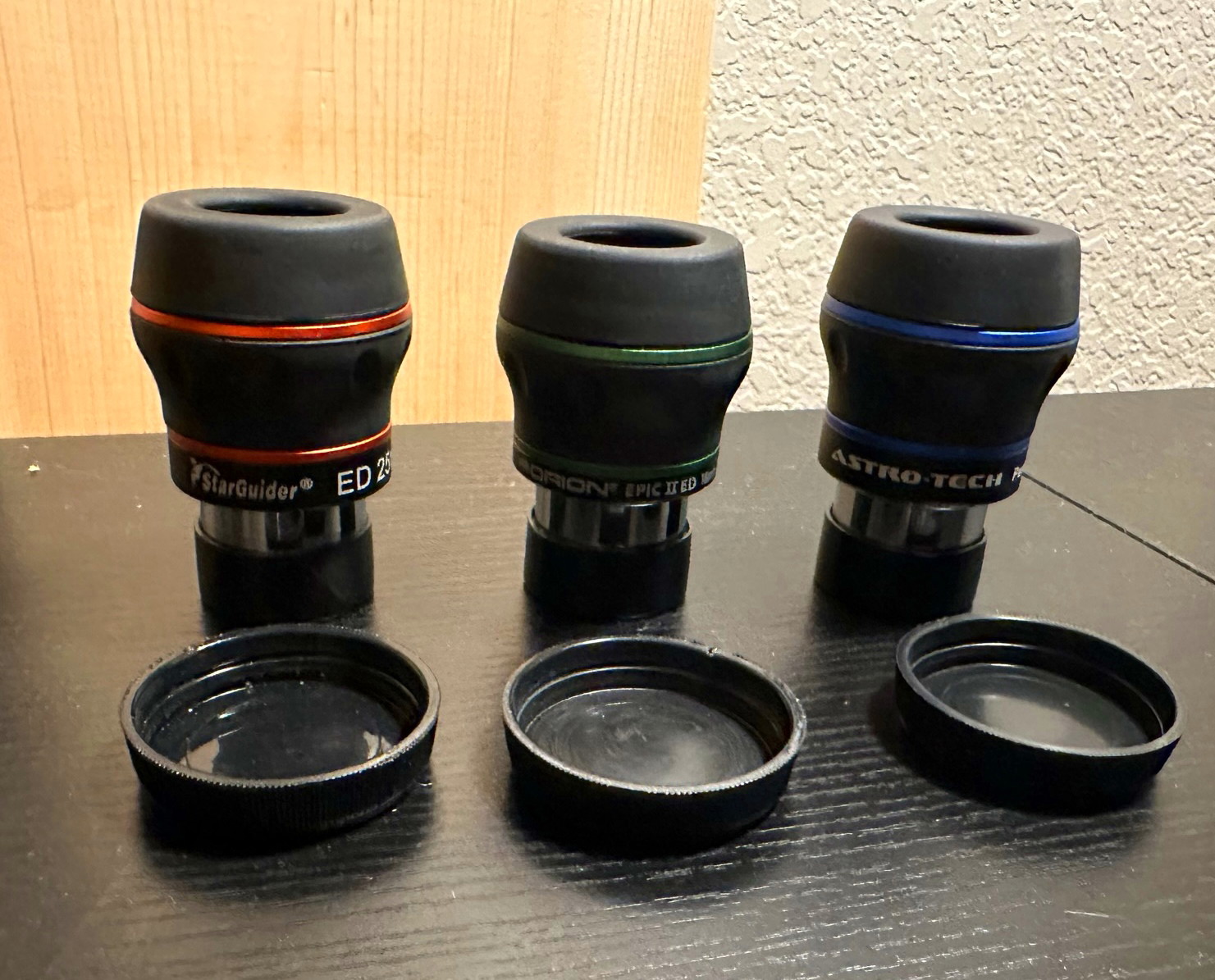
3. $100 to $200 Range: Celestron Ultima Edge
Eyepiece barrel diameter: 1.25″ for 10mm, 15mm, 18mm and 24mm focal lengths. 2″ diameter for the 30mm focal length eyepiece
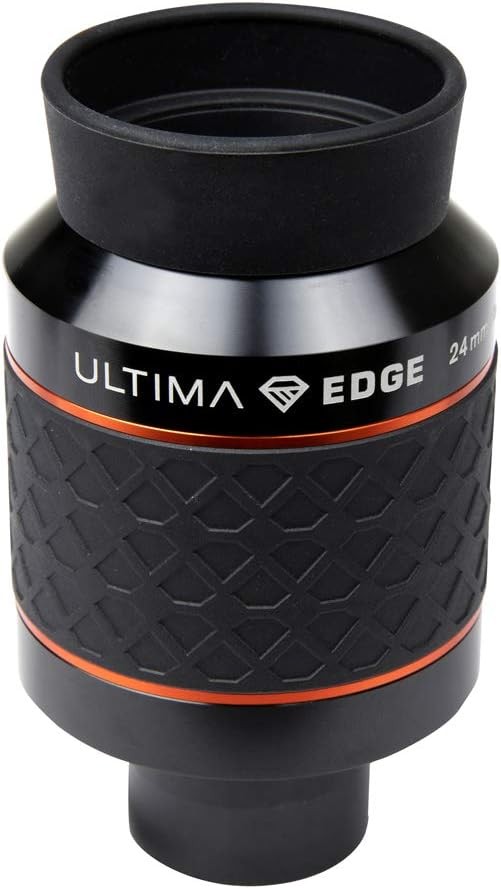
- Wide 60-70 degree apparent field of view with no field curvature
- 24mm provides near-maximum true field achievable in a 1.25” format
- Sharp in fast f/ratio telescopes too
4. $200 to $300 Range: Explore Scientific 82-Degree
Eyepiece barrel diameters: 1.25″ for 4.5mm, 6.5mm, 8.5mm, 11mm, and 14mm focal lengths. 2″ diameter for 18mm, 24mm, and 30mm focal lengths.
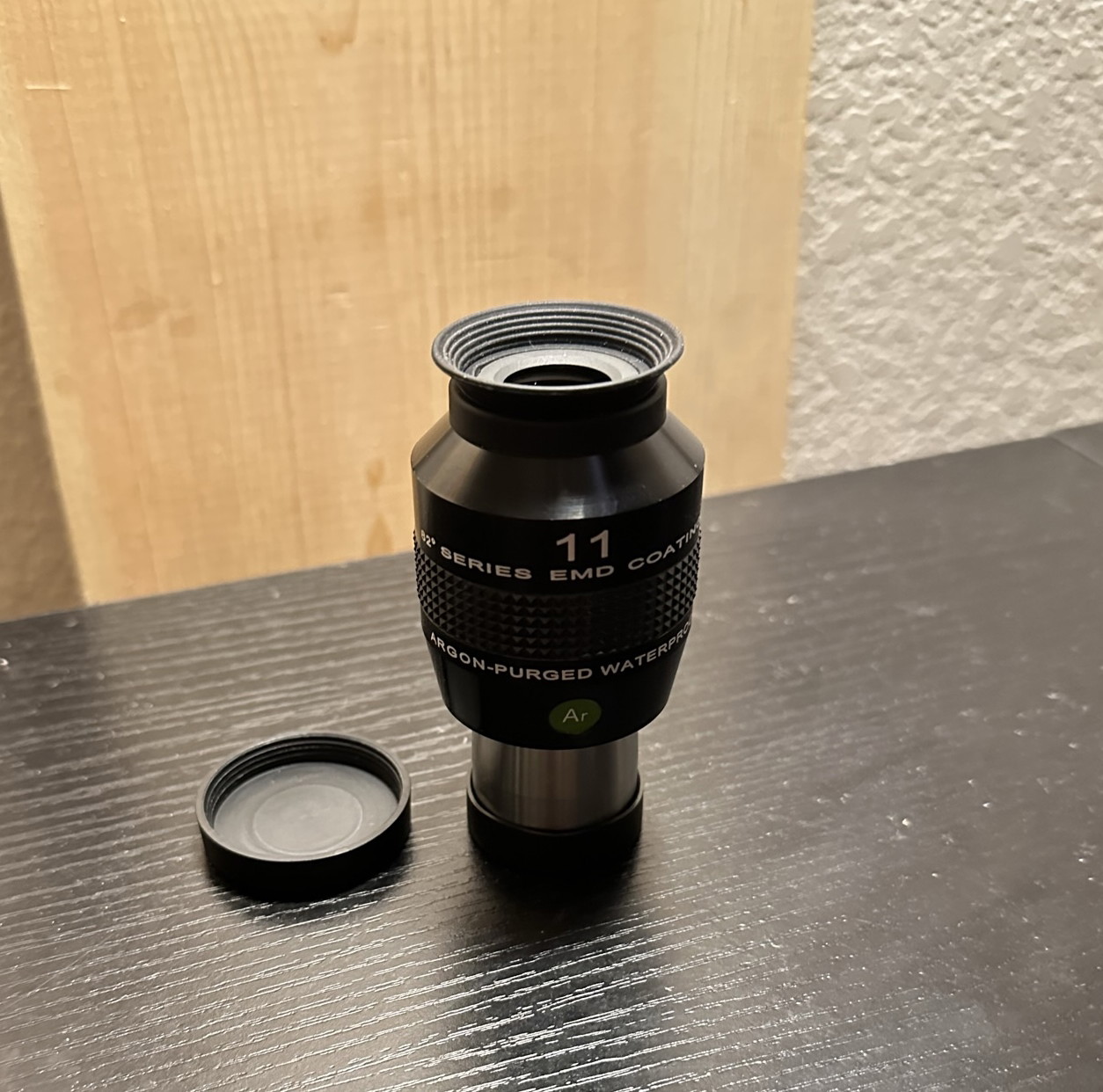
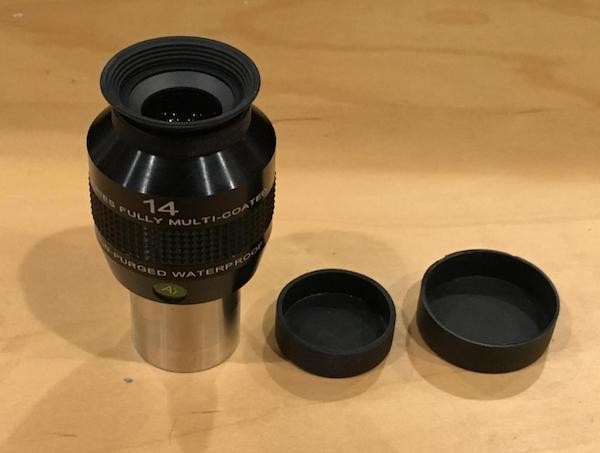
- Wide 82-degree apparent field of view
- Cheaper than many other 82-degree eyepieces and sharper than bargain-basement models
- Argon purging prevents fog or fungus
5. Above $300: Nikon NAV-HW
Eyepiece barrel diameter: 1.25″ for 4.5mm, 6.5mm, 8.5mm, 11mm,] and 14mm focal lengths. 2″ diameter for 18mm, 24mm, and 30mm focal lengths.
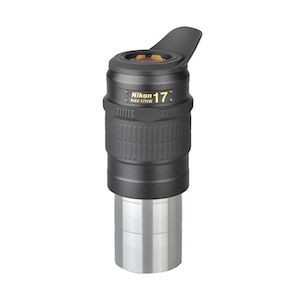
- Sharp, wide and extremely immersive 102-degree apparent field of view
- Excellent performance at all focal ratios
- Long eye relief
- Premium build and optical quality
- Glow in the dark eyeguard
- 2-for-1 package thanks to provided Barlow/tele-extender lens
Nikon’s internationally successful NAV-SW series has paved the way for the new NAV-HW series, boasting an ultra-wide 102-degree field of view. This series features two focal lengths: the 1.25″/2″ 12.5mm NAV-12.5HW and the 2″ 17mm NAV-17HW. Each eyepiece comes with a specially designed “EiC” tele-extender lens at no extra cost, which can be screwed onto the bottom of each eyepiece, reducing the focal length of the 17mm HW to 14mm and the 12.5mm to 10mm. This means you effectively receive two eyepieces for the price of one!
The 17mm NAV-HW’s barrel is unnecessarily long, and for use with a coma corrector like the Tele-Vue Paracorr or ES HRCC, you may end up having to install a parfocalizing ring to keep the bottom of the eyepiece as close as possible to the coma corrector lens without actually touching it. Nikon provides one, but it is actually too thick for this purpose, though it is necessary to avoid hitting the mirror/prism in a 2” star diagonal.

Brilliant article and I thank you for it, I was literally really confused prior to reading it.
Thanks for your comment. Glad you found it helpful.
You alluded to them, but you never mentioned Tele Vue. As the clear cut worlds best eyepiece manufacturer, their name should at least be mentioned in an article like this.
GeoDad,
I agree. In retrospect, I should have included Tele Vue.
Hello sir, thanks for your article it’s realy helpful. I need your advice on it. I wants to install one in house(fixed place) another I need movable. I want these as possible as wide, magnification and astrophotography purpose. Can you suggest the total . I am looking for as much as best I can buy. No price limit. Can you help me. You can email me also.
No price limit? That is a wonderful expression. I hope I can say that someday. And certainly, if you are getting into AP you are going to need that big budget.
Sorry but I am not offering a configuration and pricing service. Even if we were next-door neighbors this would take weeks of discussion and planning. And I am a visually observing focused person. I don’t dabble in AP. Perhaps you should seek out help from your local astronomy club.
Remember that visual and AP have very different requirements, so plan on at least two different optical tubes. But for AP you should really start your planning with the mount.
https://telescopicwatch.com/best-telescope-mounts-for-astrophotography/
Then you look at the optical tubes. This might contain more of what you need.
https://telescopicwatch.com/best-astrophotography-telescopes/
Visual astronomy is all about aperture, the more the better. AP is all about the mount and accurate tracking.
Best of luck.
OHHH, now i get it! now it all makes sense, you did a great job explaining all this information it was a lot to take in but i have it now. thanks Ed
Excellent, thank you for the breakdown, very much appreciated.
ES 82 degree series plus 1 meade uwa @20 mm – with 1800 focal length optical tube – lowest mag 51 x / highest mag 300
EP-mm = magnification = afov
6.7 = 268 = .3
8.8 = 240 = .34
11 = 163 = .5
14 = 128 = .6
20 = 90 = .8
30 = 60 = 1.3
did i pass? thanks for all your help.
Outstanding job Jack. You really understood the material.
Now, for my one or two low power eyepieces, I also like to know the field of view provided by that eyepiece. This can be very helpful for star hopping.
Take the AFOV of the eyepiece (provided by the mfg) in your case 82 degrees
Divide that by the magnification of that eyepiece in that scope
So, for your 30 mm, 82/60 = 1.36 degrees. It may be a bit less than that in reality but for practical purposes that is close enough. So if you need to go to Arcturus and then go 2 degrees to the right to find your target, you can use the FOV of the eyepiece to estimate 2 degrees.
Again, I only do this for my low power wide views. In your case, I would do this for the 30 and the 20.
Hope you find this useful.
Thanks so much.
I took notes and now can shop with confidence
Scott
There is always more to learn but it helps if you go in with a good base understanding, and that was my goal.
I continue to be very pleased with the ES82 eyepieces. I just added the 4.7 mm. And I continue to read excellent reports on the AT Paradigm and similar under different labels.
Hi Ed,
Very nice article. I would like to know what is best for a 7 year old that would be getting his first telescope.
-Joe
As you saw in the article, they eyepieces that would be best for you, or your child, is based on your budget and what your goals are. Age is not part of the equation.
If you want to buy him $200 eyepieces so he can grow into them, that works. If you would prefer to buy him $60 eyepieces or even $30 eyepieces because he is only 7 and he can upgrade later, that is also OK. It is all about your budget, your goals, and your objectives, as outlined in the article.
As a kid, I loved looking at the moon (which can be seen any time of day, regardless of one’s bedtime)… so make sure that the field of view is wide enough to see the whole shebang.
Also, children do not often have highly developed motor skills–so I would avoid the frustration of switching out eyepieces, and consider a zoom lens.
One last thing, as a kid I used my telescope to watch squirrels and birds (which was interesting because the image was flipped around :-)… so, you might consider getting an eyepiece that flips things the right way around so that navigating terrestrial nature is easier to manage.
PS. I don’t know if they make anything like this anymore, but as a kid, I had plastic slides with images on them (the Milky Way, Horse Head Nebula, etc.) that I could slide into my telescope and look at.
Interesting points Philip. I agree with your comment on zooms for kids. Us big kids like zooms too. 🙂
With a refractor, SCT or MCT, it is usually better to get a correct image diagonal than a correcting eyepiece. I expect such eyepieces are available but I have never seen or used one. I am not aware of any such solutions for Newtonian reflectors.
One more thing… if you haven’t purchased a telescope yet, I would recommend a tabletop version, since they are easier for kids to move than the fiddley ones with spindly legs and complicated dials.
As for tabletop scopes, don’t forget that you need a table, stool, or bench to place them. If that surface is wobbly the scope will be almost useless. So plan this into such a purchase.
Any recommendations the table, stool or bench?
Yes, eyepieces is a large and complex topic. We often end up spending more on eyepieces than we did on the telescope. Fortunately, the investment can be leveraged with future scopes since eyepieces are standard sizes so they work in almost any telescope.
This was very useful, I got a meade infinity 90mm – ( after read the review here 🙂 -. Now looking for a couple of decent eyepieces. Thinking in a super ploss 32mm and maybe something between 9mm and 15mm .
Hayppy that now I have more facts to put in my decision.
Again thank you very much for all the information in the page, excellent notes.
Be sure to read the following as you consider your eyepiece purchases.
Understanding and using a Barlow Lens
https://telescopicwatch.com/best-barlow-lens-and-how-to/
Celestron 8-24 Zoom Review
https://telescopicwatch.com/celestron-8-24mm-zoom-eyepiece-review/
Nice, thank you again for the additional inputs.
Hi Ed,
Great article on eyepieces but I am still undecided exactly what eyepiece & Barlow to buy and from where since some buying sites don’t provide all the info you cite in your article. I purchased the Celestron Starsense 102mm refractor, focal length 660mm, stated highest useful magnification is 240x; it should arrive in about 2 weeks. It comes with 1.25” Plossls 25mm (26x) and 10mm (66x) eyepieces.
I am considering buying another eyepiece, maybe 6mm, and a Barlow, maybe 2x, to give me a wider and higher range of magnification.
You noted eye relief is important for those wearing glasses. I am very near-sighted, barely see the big E on the vision chart without glasses. However, i can read very well without my glasses with almost microscopic vision and can use my binoculars without glasses. However, sometimes i am at the end of the range of the binocular focus adjustment.
Can you give me any specific recommendations on what to buy and from where? With regards to budget, whatever works well and is on par with the quality & capability of the telescope. Thanks, Angelo M.
You picked a great first scope. My friend has one and he really likes it, and it is his third telescope.
In terms of eyepieces, my best advice is provided in the article. I would wait till you get the scope and use the included eyepieces. See if you will observe with or without your glasses. That is the critical factor.
If you are going to wear your glasses when you observe, you want at least 18 mm of eye relief and 20 mm is better. Why not go back to the people who sold you the scope and get their help. Or, if you are buying from an online like Amazon, then look at the eyepieces I recommend and see if any suit your needs. But you need to know, first, if you will be wearing glasses when you observe.
As for Barlow Lenses, take a look at this article.
Understanding and using a Barlow Lens
https://telescopicwatch.com/?s=barlow
Best of luck with your new telescope. I think you will love it! Just give yourself some time to learn the app and to understand the scope. If you stumble the first few uses, don’t be discouraged. Every new skill takes time. And remember, when all else fails, read the instructions. 😉
Clear skies!
Hi Ed,
I’ve read, and re-read, and re-re-read this page. I cannot thank you enough! Sooooo helpful!
I also just bought the Celestron Starsense 102mm refractor (650mm focal length, f/6.5) as a first scope for me and my kids. We also joined our local Astronomy Club and look forward to joining others under the night sky when the opportunity presents itself again.
Being a total novice, I love the StarSense app and technology. It has made learning the Constellations and star-hopping more fun and engaging for my whole family — exactly what I was hoping for.
I’ve read reviews about my scope. Every review suggests replacing the 10mm Kellner eyepiece (and possibly 25mm Kellner) that comes with it. Some reviews also suggest replacing the diagonal.
https://telescopicwatch.com/celestron-starsense-explorer-dx-102-130-reviewed/
If I was to upgrade these lenses, I was planning on working toward something like this:
2x Barlow
6.5-ish mm (100x & 200x)
8.5-ish mm (75x & 150x)
32mm (20x & 40x)
I guess my curiosity is mostly about the diagonal. I couldn’t find any suggestions on your site about diagonal recommendations. I’m also uncertain about what to expect from an additional investment? We enjoy binoculars for the moon, but having never looked through another telescope, my kids and I do not know what internal reflection, ghosting, vignettes, or diffraction spikes look like! For our experience level, would you recommend changing anything right now? As we continue, what would you recommend adding first? Second? Etc.?
Thank you so much for taking the time to provide all this information!
You have selected a very good starting telescope that will serve you for many years to come. I often recommend it.
I don’t have a specific diagonal to recommend and I am not aware of any specific issues with the one that is included with the scope. Any 1.25″ diagonal should work. Prices can run from $20 to $200 so the field is pretty broad.
If there is a local club, I would suggest you visit and consider joining. Just search on Astronomy Club and you will probably find one in your area. Not only is it good to share the experience but you can get first-hand advice on things like diagonals and may even be able to try one in your scope to see if it makes a difference.
If you feel the need to buy something now, consider this Orion diagonal. I don’t own nor have I used it, but Orion has a very good reputation. If you are upgrading, avoid ones that say correct image as these add a prism system into the diagonal which can reduce the light transmission. The image will be reversed left to right so you will need to get used to that. Correct image diagonals are easier for beginners and they are great for using the scope during the day, but experience people don’t use them for astronomy.
https://www.amazon.com/Orion-8879-1-25-Inch-Enhanced-Telescope/dp/B000BMPBLK/ref=sr_1_8?crid=3KKUJRXYYN7DI&dchild=1&keywords=telescope+diagonal+1.25&qid=1610887695&sprefix=telescope+diagonal%2Caps%2C512&sr=8-8
Excellent article and very good recommendations. But I have one little niggle. Using your example: “We will use a 100 mm telescope with a 600 mm focal length” and “Another way to look at it is that a 30 mm eyepiece in a 3X Barlow works like a 10 mm eyepiece.”
As I’m sure you know, a Barlow actually narrows the cone of light that enters the eyepiece, hence it affects the apparent focal length and thus the f/ratio of the telescope objective. So your 600 mm example (f/6) becomes, in effect, an 1800 mm focal length, f/18 but it does not change the focal length of the eyepiece.
Thus the 30 mm eyepiece in a 600 mm telescope produces 600/30 = 20X magnification while with the Barlow, we have 1800/30 = 60X. The magnification and field of view is the same as a 10 mm eyepiece (AFoV being unchanged) in a 600 mm telescope but the eye relief is that of a 30 mm eyepiece.
You are talking about the technical details of how a Barlow works, and I agree. But the conventional way of expressing it is in terms of eyepiece focal lengths. The result in magnification is the same and the eye relief associated with the eyepiece is retained or, in some cases, actually lengthened a bit.
Suggesting an F6 scope becomes an F18 would also imply things like reduced CA in a refractor. A Barlow lens will not reduce the CA in a low FR achromat refractor so to speak of it changing the focal ratio would, I think, introduce confusion in most situations.
So speaking of the Barlow as if it modifies the FL of the eyepiece, while technically not correct, does provide an easier model to understand the net effect. And since this article is intended as an aid to beginners rather than a rigorous optics lesson, I think the context I provided works well enough. But your point is well taken.
In High School, they told me that F=MA In college I learned that F=dp/dt But F=MA works well enough for most situations and that is how I think of it.
Clear skies!
Hi Ed. Very nice review. Thanks
You mentioned regarding ORTHO eyepieces: “Excellent specialty eyepieces, usually for planets. They have a narrow AFOV but have a reputation for being very sharp.”
Question: would an 18mm Baader Classic Ortho mostly used for Moon and planets loose sharpness and contrast if used with a short F5 telescope like the Celestron Astro-Fi 130?
Question: would it perform well with 1.5/2x and 3x Barlows?
You are asking about a very specific eyepiece in a very specific scope combined sometimes with a Barlow. I can’t answer that specifically as I have no experience with that eyepiece in that scope.
What I can say is that, in general, eyepiece characteristics are inherent to the eyepiece. If we want to get VERY specific to a combination then inherent aberrations of this scope and that eyepiece could produce a unique result. That can only be shown through actual testing.
Where a difference can show up is that a lower number focal ratio scope will make it harder for an eyepiece to provide a uniformly good, in-focus image all the way across the field of view due to the steeper angle that the light arrives at the edges of the eyepiece with a low focal ratio scope, as compared to a high focal ratio scope.
To say it a different way, in general, an F5 scope will place more demands on the eyepiece around the edge of the field of view than an F10 scope. This will become more apparent the wider the AFOV is of the eyepiece, in my experience. And, the quality of the eyepiece clearly comes into play here. So we say that an F5 scope benefits from “better corrected” eyepieces more than the F10 scope. Or we say that F10 would be easier or less demanding on the eyepiece than the F5.
This is where the cheap eyepiece will frequently fail to deliver a good image, around the edges.
Typically a Barlow does not add or subtract from this, but there again we have bad Barlows and Good Barlows. So you would have to test the set to see the actual result.
Thanks Ed for your valuable comments.
With a 130mm-F5 I would use a Plossl 32mm for its low-mag-wide-view. But for the targets requiring higher mag I’m still undecided between:
– a Celestron 8-24 Zoom with a 2x Barlow
– or a Baader Classic Ortho 18mm with both a 1.5/2x Barlow and 3x Barlow.
Both solutions offer somewhat similar mag-fov-er-price.
But will the Baader CO with 1.5-2-3x Barlows deliver a visibly sharper and more contrast view of the Moon and planets than the zoom lens with a 2x Barlow, to compensate for the zoom’s convenience… that is the question!
Do you have any additional comments to help me?
I am a BIG fan of zoom eyepieces, especially if you don’t have many. I have Celestron and the Baader Hyperion. Depending on your budget, if you only have limited funds and are just starting to fill out your eyepiece collection I would go with the zoom, then zoom with Barlow. You can add the specialty single FL eyepieces later if you wish.
This can be debated 100 ways, but that is my advice.
Another really helpful article, Ed. Our previous exchange convinced me to start out with an 80mm refractor. Though not the Meade. I decided to jump in with both feet and get an Orion ED80 (600mm f7.5 with a 2” focuser, So that I can move into astrophotography down the road.
I must say I’m quite confused about eyepieces. I think I’d really enjoy a zoom for all the reasons you mention, But I’m having a difficult time assessing how much weight to put on the field of view of given eyepieces. Is it just about finding and framing, or do wide fov EPs create a more immersive experience? Like going from a 32” TV to a 65”? The Baader offers wider fov, but at quite the price premium.
How does that field of view impact the viewing experience? Besides fov, How would you compare the optical quality of the Celestron to the Baader?
What should one opt for a 2” EP over a 1.25? I see that there are some optical limits to how wide an FOV a 1.25 EP can manage at bigger (like 32mm) focal lengths. Again, does it create a more immersive viewing experience? If you had to choose 1 low-power 2” EP for chasing deep sky objects (again, at 600mm f7.5), what size piece would you go for? Are there any good low-cost 2” EPS out there?
Sorry for another wish list 🙂
Field of view, is about finding, framing, drift time, and context. These are matters of individual preference and budget. As to a more immersive experience, yes, I would say a wider FOV does provide a more immersive experience.
I have to say that your questions are answered in the article. Perhaps another review would be helpful.
Hi, I have recently bought a Orion XT8 and am trying to work out which eyepieces to add to what is provided with the scope. The telescope comes with a 2x Barlow so I was thinking of getting one of the zooms you recommended. Is there much of a difference between the celestron and haader? I’m fairly picky so would extend budget for better eyepieces if its worth it. Does this sound like something you would recommend based on the telescope I have? I am very interested in viewing Nebulae – do you think this set up will work well for that or do I need other eyepieces or filters? Also worth mentioning i wear glasses which I will wear while observing. Many thanks, Sophie
I owned an XT8 Intelliscope which is the same optical tube on a PushTo mount.
Orion SkyQuest XT8 Intelliscope Review
https://telescopicwatch.com/orion-skyquest-xt8-intelliscope-review/
My Baader Hyperion Zoom is my most used and favorite eyepiece. If I had to give them all up and keep only one eyepiece, It would be the BH Zoom.
With the XT8i I usually used the zoom configured with a 1.5X Barlow giving me a 75X to 225X which I found to be nearly perfect for that scope. Under my sky it was rare that I would be able to get over 225X and still maintain a good quality image, except on the Moon. My Barlow is a 2X with a removeable Barlow element that can be screwed right onto an eyepiece giving a 1.5X effect. So you ended up with:
50 – 150X, no Barlow
75-225X, 1.5X Barlow
100-300X, 2X Barlow.
My other eyepieces, ES and Meade 82 degree, stayed in the eyepiece case most of the time. I have since moved up to a 12″ Dob but I use the same eyepieces and the BH Zoom continues to be my most used.
I would suggest you also get a 2″ low power wide view. Something in the 30 to 38 mm range with a 65 to 70 degree AFOV. Orion Q70 38 mm works well. Explore Scientific 68 34 mm or ES 82 30 mm would also be good choices at a significantly higher price but with better edge correction. I like my 38/70.
I hope that helps.
The BH zoom is optically a 1.25″ eyepiece. However the package includes a 1.25 to 2″ adapter so if you have a 2″ focuser you can treat this like a 2″ eyepiece leaving the adapter normally included with the scope for use with other 1.25″ eyepieces. The BHZ 2″ Adapter has threads on it so you can attach filters to it allowing you to use 2″ filters with the zoom. Any 1.25″ eyepiece will work with the BH Zoom 2″ adapter. The zoom can be used with any 1.25″ focuser too.
You can find the eyepieces I use and recommend in this article. They include links to them where they can be ordered. The only one not in the article is the Orion Q70 which is available in 38 mm, 32 mm and 26 mm. I have the 38 mm and recommend it often.
https://www.amazon.com/s?k=Orion+Q70&ref=nb_sb_noss_2
Understanding Telescope Eyepieces- There are recommendations, based on budget,
but the meat of the article is about understanding the considerations and specifications to know when selecting eyepieces.
https://telescopicwatch.com/best-telescope-eyepieces/
Explore Scientific, like many eyepiece providers, have higher-priced and budget lines. I am not aware of an ES branded 70 degree series in the USA, but they do have a Bresser branded 70-degree series. I beleive this is the same as they ones you asked about. They are just OK, but I don’t recommend them, especially in a low focal ratio scope. I had one and sold it.
I would recommend the Orion Q70 series over that. I have used these in my F6 and F5 Dobs and find them a good value for the price. Not perfect to the edge but better than the Bresser, in my opinion.
https://www.amazon.com/Orion-8829-Wide-Field-Telescope-Eyepiece/dp/B000M89H7C/ref=sr_1_2?dchild=1&keywords=Orion+Q70&qid=1606584502&sr=8-2
The Explore Scientific 68 degree series would be better but at a much higher price.
https://www.amazon.com/Explore-Scientific-68%C2%B0-40mm-Eyepiece/dp/B007LMG3F6/ref=sr_1_1?dchild=1&keywords=explore+scientific+68&qid=1606584676&sr=8-1
Hi Ed,
Thanks for your reply, I think I will go for the Orion Q70 🙂
Do you think it would be sensible for me to look at getting a higher magnification specific eyepiece? I saw Jupiter today and its 4 moons but when I looked at saturn I struggled to get a really clear image and it was very small. I also struggled to see features on both (gas bands on Jupiter and clear rings on saturn). Would a higher magnification eyepiece help do you think or am I already pushing my telescope (XT8) to highest sensible magnification I can with BH zoom on setting 8mm and 2x Barlow?
Many thanks
Sophie
Jupiter and Saturn are low in the sky now. You are looking through a LOT of atmosphere which distorts the image. This has nothing to do with your scope or eyepiece.
The BHZ in a 2X Barlow will take an XT8 to 300X. On many occasions, that will be too high power for the atmospheric conditions. I often had to drop back to about 180X because of poor seeing and transparency. Look those up, “seeing” and “transparency” in the context of astronomy.
Ah I see what you are saying, I had wondered whether this might have had an impact as I’ve seen it mentioned before but don’t fully understand it so will do some research, thank you 🙂
Was compairing the Apertura standard 15mm Plossl with their 15mm super wide angle eyepiece (70 afov). I already got the 10mm super wide because of the added eye relief but at 15mm both have the same eye relief. I also have a 25mm plossl and am happy with that. Does having a 70 vs 52 fov make a noticeable difference for double the price? These will eventually be used in an 8in dob whenever it arrives.
If you read the article you know how to calculate the magnification and field of view. Both will provide the same magnification. You can do the calculation which will show that the 70 will have a significantly wider field of view as compared to the 52.
Do you think the Baader Hyperion Zoom would work OK with the Skywatcher 150p? Or is this overkill and am I better off saving money and going forward something like the Celestron Zoom? Many thanks.
I would recommend the Baader Hyperion Zoom for any telescope. However, your budget must guide your purchases.
A key thing to remember is that eyepieces are universal. You can buy eyepieces specifically focused on a particular scope or you can buy eyepieces that you expect to use with this and all future scopes.
When I started, I purchased less expensive eyepieces to learn about them and how I would use them. I started with the Celestron zoom. I still have it and still use it from time to time. Once I knew how much I liked the zoom I upgraded to the Baader Hyperion Zoom.
I have a variety of eyepieces, including Explore Scientific and Meade 82 degree series so I have choices. However, the BH Zoom is by far my most used eyepiece. If you are investing for the future, get the BH zoom. If you are just testing the waters or on a tight budget, get the Celestron, which is still pretty good. I recommend it often to beginners on a tight budget.
I recently purchased the SVBony 7-21 zoom from Amazon. This is a fairly inexpensive zoom that I wanted to try. I have not had an opportunity to test it yet but the general discussions have favorable. I would expect it to be similar to the Celestron in image quality. If that is the case, it will give me another reasonably good, inexpensive zoom to recommend to beginners. Most likely it will be used as a loaner eyepiece to go with one of my two loaner telescopes.
OK that makes sense, many thanks. I think I will go for the BHZ because, as you say, I will be able to use it now and into the future.
Thanks for a very helpful guide. I’m just starting out with astronomy and this really helped my understanding.
I have seen elsewhere discussions about the exit pupil of eyepieces. How important a consideration is this when deciding on an eyepiece? What happens if you use an eyepiece that has a the ‘wrong’ exit pupil?
Thanks.
You will get varying opinions on this but I would not worry too much about this. In my opinion, there are no wrong exit pupils.
Any exit pupil between 7 mm and .5 mm is just fine. However, I have eyepieces that have larger exit pupils than 7 mm and they work well. Below .5 mm exit pupil, floaters in the eye become more apparent and can be bothersome. However, I have eyepieces with much smaller exit pupils and they work fine.
The one exception I would keep in mind would be when working with Newtonian reflector telescopes below F5. An exit pupil larger than 6 mm may start to show a shadow of the secondary mirror. This is not a hard and fast rule, just a cautionary note. I have an F4 Newtonian reflector and if I use an eyepiece of longer than 25 mm, an exit pupil of 6.25, I start to get a dark area in the center of the field of view which is a shadow of the secondary mirror.
I often recommend a 32 mm Plossl as a good low power wide view eyepiece for scopes with a 1.25″ focuser. But in this scope, the 32 mm doesn’t work well.
I hope that was helpful.
It certainly was, thank you.
a breath of fresh air! THANK YOU x 12!
i didn’t have all this simply-put information when i bought my orion st-80 as my christmas present to myself in 2020. i started out with several pair of binoculars i bought used off ebay, then bought the scope. i still use the binos.
still, i somehow managed to avoid the eyepiece pitfalls when buying used off ebay. i don’t have 1 of everything, and i bought the best i could afford on a low budget; meade and orion. i did buy an astro-tech 3.2 paradigm ed from a cloudynights.com forum member. very happy.
thanks again, and merry christmas 2021!
rodney
What do you think of the Luminos Celestron eyepieces? That’s what I ordered before reading your very interesting writing. Wondering if I should return them.
Great article Ed.
When you wrote “maximum practical aperture = aperture X 2” were you referring to the rule of thumb that maximum practical magnification is typically twice the aperture in mm?
Hey Ed, thanks for this beautiful overview. Telescopicwatch helped me start out in the hobby and I find myself coming back to it – so many refreshingly honest and thorough reviews, so much good advice. This time I decided to leave a suggestion: when you do a next edition, consider including the Baader Q-turret set. It’s an extremely well-priced and well-rounded set of quality eyepieces that are light, easy to use, and offer a vast range of magnification (with a nice box to carry them around). Eye relief and FoV are decent throughout and image quality is second to no other eyepiece I’ve tried. I bought a second hand box thinking “this is my starter kit” and found myself graduating… to a second box of the same! I’ve also acquired bigger and more expensive EPs in the meantime, but I find myself reaching out for these most of the time. Clear skies!
Great article, very clear explanations opening my knowledge about eyepieces 80º+ not to mention the Barlow effect! Need to come back to learn more. Thanks
Many thanks for a very useful article. Based on your opinion I will invest in three Explore Scyentific 68º and 82º LER pieces to start with the Barlow 2x.
Great write up Ed. If folks are willing to order direct from China, Sky Rover is yet another brand that sells the UFF eyepieces, and they are the cheapest option I have seen. EyepiecesEtc.com used to sell the APM version for a great price, but unfortunately their doors are now closed.